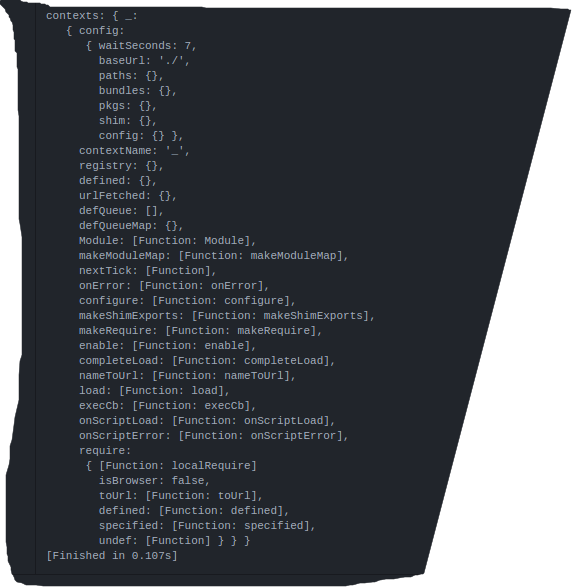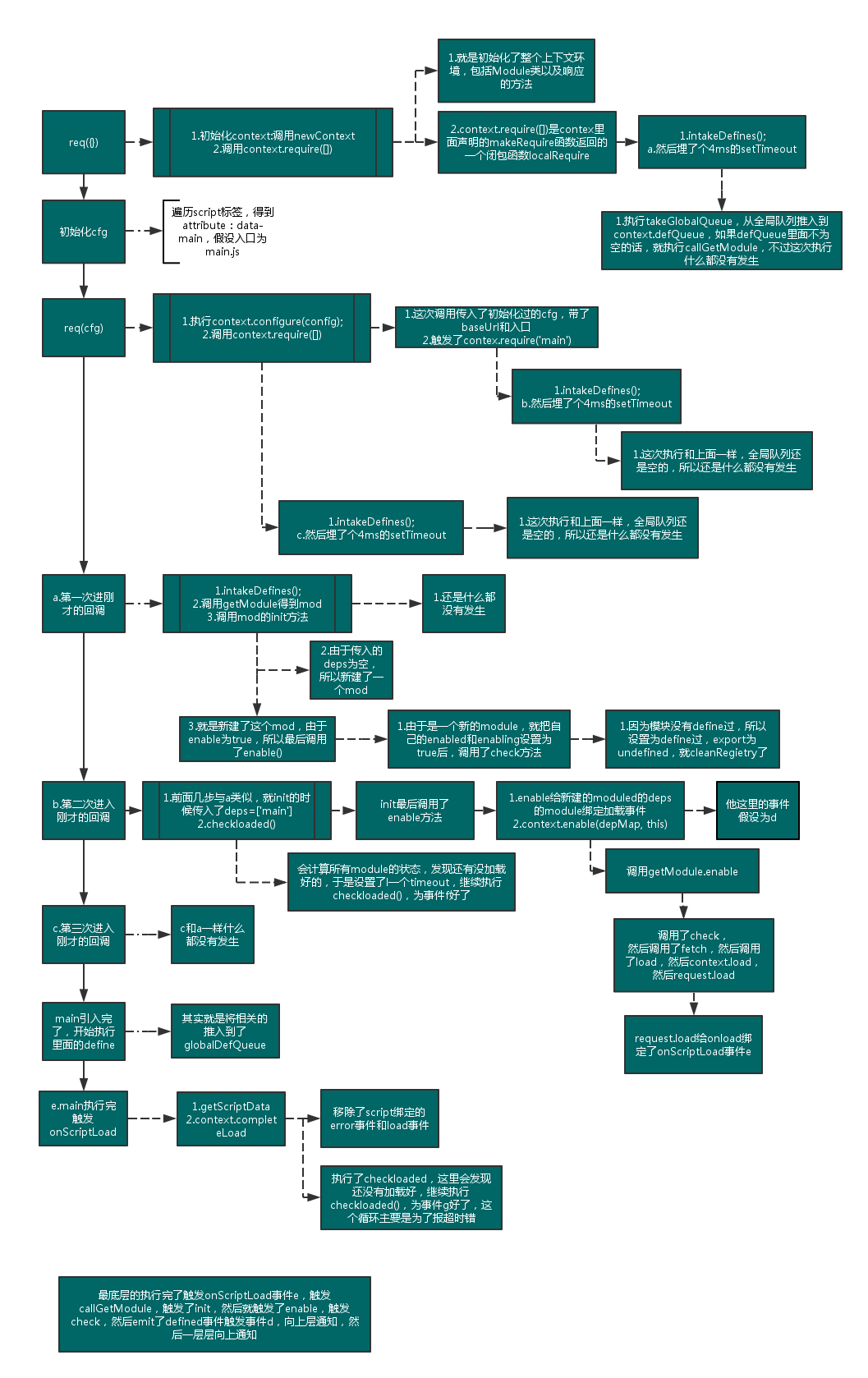一步一步带你分析 requirejs
详细源代码一共就2000多行,来看我这篇分析的同学应该都下载下来了,好了,话不多说,开始:
代码的开头就出现3个全局变量: requirejs, require, define
- var requirejs, require, define;
- (function(global, setTimeout){
- balababla......
- })(this, (typeof setTimeout === 'undefined' ? undefined : setTimeout)))
require 和 define 大家应该都知道上干什么的,说实话,我是不知道的,在分析代码的时候,我从来也没用过这个框架,就听过AMD,就来直接看源码了。
如果你也不是很清楚,这2个变量是干什么的,我就来简单介绍一下,懂得的同学要是发现我说错了,希望指点我也一下。
主页面 index.html:
注意src是引入我们的requirejs库, data-main:就是我们第一次用requrie的地方:
- <html>
- <head>
- <title></title>
- </head>
- <body>
- <script src="require.js" type="text/javascript" data-main="main.js"></script>
- </body>
- </html>
main.js:
这里2个代码块都是依赖require的:
(1)require.config:配置
(2)requrie(); 加载需要的函数,注意里面的 ['name', 'say'],其实都是文件名,它们都在./js/ 目录下,具体看conifg
- require.config({
- baseUrl: '',
- paths: {
- 'nameDep': 'js/nameDep',
- 'say': 'js/say',
- 'name': 'js/name'
- },
- shim: {
- 'name': {
- deps: ['nameDep']
- }
- }
- });
- require(['name', 'say'], function (name, say) {
- say(name);
- });
./js/name.js 和 ./js/say.js
- //name
- define([''], function () {
- return '测试';
- });
- //say
- define([], function () {
- return function (name) {
- console.log(name);
- };
- });
最后注意在config中有个skim,这里面也是定义js文件的,只是由于他可能不符合AMD加载的规范
./js/nameDep.js
- console.log("nameDep.js")
以上分析,我们大概看得出 require 和 define 都是 function
--------------------------------------分割线-------------------------------------------------------------------------
下面进入2000多行匿名函数的讲解:
首先说一下2个参数: global 和 setTimeout
- (function (global, setTimeout) {
- })(this, (typeof setTimeout === 'undefined' ? undefined : setTimeout))
如果在浏览器的环境中,就是平时我们所知的 windows对象 和 windows.setTimeout方法 。本文只讨论浏览器环境,别的环境咱不考虑。
接下来就是一大堆的变量和函数的定义,太多了!反正我就扫了一眼,记不住?无所谓,只需要记住这开头这3个变量就行了:req,contexts,cfg
2个是空对象 cfg,contexts ,还有一个函数 req 。
为什么它是函数??? 你一拉到底,一定会看到 req = requirejs = function(){} 的定义,眼神不好也没关系,看我下面的代码框里有req({});
- var req,
- ....
- contexts = {},
- cfg = {},
- ....
- //各种function定义
- ....
- //Create default context.
- req({});
- .....
好了把眼神定位到 req({})吧, 因为这是上面一大堆定义后,第一次执行了代码!!!!
req这个函数长什么样子?? 你用文字匹配往上找:
- /**
- * Main entry point.
- *
- * If the only argument to require is a string, then the module that
- * is represented by that string is fetched for the appropriate context.
- *
- * If the first argument is an array, then it will be treated as an array
- * of dependency string names to fetch. An optional function callback can
- * be specified to execute when all of those dependencies are available.
- *
- * Make a local req variable to help Caja compliance (it assumes things
- * on a require that are not standardized), and to give a short
- * name for minification/local scope use.
- */
- req = requirejs = function (deps, callback, errback, optional) {
- //Find the right context, use default
- var context, config,
- contextName = defContextName; //开头定义了 defContextName = "_"
- // Determine if have config object in the call.
- if (!isArray(deps) && typeof deps !== 'string') {
- // deps is a config object
- config = deps;
- if (isArray(callback)) {
- // Adjust args if there are dependencies
- deps = callback;
- callback = errback;
- errback = optional;
- } else {
- deps = [];
- }
- }
- //第一次没有config.context 跳过
- if (config && config.context) {
- contextName = config.context;
- }
- //第一次context == undefined
- context = getOwn(contexts, contextName);
- //第一次进入
- if (!context) {
- //只有第一次会调用newContext("_")
- context = contexts[contextName] = req.s.newContext(contextName);
- }
- if (config) {
- context.configure(config);
- }
- return context.require(deps, callback, errback);
- };
上面代码 context出现的频率非常高,说明这小子很重要。那我们来看看这小子到底是啥!!!
直接找到它的定义:
- context = contexts[contextName] = req.s.newContext(contextName);
那 newContext 又是什么鬼! 搜它!!!!!
- function newContext(contextName) {
- var context
- ...
- //一大堆function定义
- ....
- context={
- .....
- }
- context.require = context.makeRequire();
- return context;
- }
用20秒的时间扫一眼!老套路,一大堆的变量,函数的定义。 一直到最后return 一个 context变量。
再往上拉看看 context 到底是个什么鬼!!
记忆力没毛病的话,发现context对象里装的全是刚才定义过一些变量,函数。
-----------------------------------------------------------------------------------------------
| 其中return的上一行代码: |
| context.require = context.makeRequire(); |
| 有兴趣就去看一眼,很简单,就是返回一个叫localRequire的闭包 |
------------------------------------------------------------------------------------------------
OK,这个newContext函数我们已经差不多了解了,就是返回一个对象,通过这个对象控制newContext里的一系列私有变量和对象。
我们的contexts就如下图所示:

接下去走
context.configure(config);
我建议你去看一下,因为里面啥也没干,你只需要花10秒左右的时间就可以看完。。。
然后走
- return context.require(deps, callback, errback);
看上面的图,context.require 就是 localRequire
接下来,我们走进localRequire的世界里一探究竟!!!!其中deps = [ ]
- function localRequire(deps, callback, errback) {
- var id, map, requireMod;
- if (options.enableBuildCallback && callback && isFunction(callback)) {
- callback.__requireJsBuild = true;
- }
- if (typeof deps === 'string') {
- if (isFunction(callback)) {
- //Invalid call
- return onError(makeError('requireargs', 'Invalid require call'), errback);
- }
- //If require|exports|module are requested, get the
- //value for them from the special handlers. Caveat:
- //this only works while module is being defined.
- if (relMap && hasProp(handlers, deps)) {
- return handlers[deps](registry[relMap.id]);
- }
- //Synchronous access to one module. If require.get is
- //available (as in the Node adapter), prefer that.
- if (req.get) {
- return req.get(context, deps, relMap, localRequire);
- }
- //Normalize module name, if it contains . or ..
- map = makeModuleMap(deps, relMap, false, true);
- id = map.id;
- if (!hasProp(defined, id)) {
- return onError(makeError('notloaded', 'Module name "' +
- id +
- '" has not been loaded yet for context: ' +
- contextName +
- (relMap ? '' : '. Use require([])')));
- }
- return defined[id];
- }
- //Grab defines waiting in the global queue.
- intakeDefines();
- //Mark all the dependencies as needing to be loaded.
- context.nextTick(function () {
- //Some defines could have been added since the
- //require call, collect them.
- intakeDefines();
- requireMod = getModule(makeModuleMap(null, relMap));
- //Store if map config should be applied to this require
- //call for dependencies.
- requireMod.skipMap = options.skipMap;
- requireMod.init(deps, callback, errback, {
- enabled: true
- });
- checkLoaded();
- });
- return localRequire;
- }
很快我们就把目光锁定到(因为,前面的一大段代码都是if语句,不符合条件进不去)
- //Grab defines waiting in the global queue.
- intakeDefines();
intakeDefines --》takeGlobalQueue--》context.nextTick--》intakeDefines --》 requireMod.init --》 checkLoaded();
里面大致就是上面所示,因为有点复杂,我这里暂时先不说,接续走简单的。。
到此为止,我们已经走完了一边req。
大致流程如下图所示:

接下去,我们再一拉到底!!!!
倒数第二行:
- //Set up with config info.
- req(cfg);
cfg还记得是什么吗?? 一开始是定义为空对象啊!!!
有地方修改过它吗? 往上拉一拉!!
- //Look for a data-main script attribute, which could also adjust the baseUrl.
- if (isBrowser && !cfg.skipDataMain) {
- //Figure out baseUrl. Get it from the script tag with require.js in it.
- eachReverse(scripts(), function(script) {
- //Set the 'head' where we can append children by
- //using the script's parent.
- if (!head) {
- head = script.parentNode;
- }
- //Look for a data-main attribute to set main script for the page
- //to load. If it is there, the path to data main becomes the
- //baseUrl, if it is not already set.
- dataMain = script.getAttribute('data-main');
- if (dataMain) {
- //Preserve dataMain in case it is a path (i.e. contains '?')
- mainScript = dataMain;
- //Set final baseUrl if there is not already an explicit one,
- //but only do so if the data-main value is not a loader plugin
- //module ID.
- if (!cfg.baseUrl && mainScript.indexOf('!') === -1) {
- //Pull off the directory of data-main for use as the
- //baseUrl.
- src = mainScript.split('/');
- mainScript = src.pop();
- subPath = src.length ? src.join('/') + '/' : './';
- cfg.baseUrl = subPath;
- }
- //Strip off any trailing .js since mainScript is now
- //like a module name.
- mainScript = mainScript.replace(jsSuffixRegExp, '');
- //If mainScript is still a path, fall back to dataMain
- if (req.jsExtRegExp.test(mainScript)) {
- mainScript = dataMain;
- }
- //Put the data-main script in the files to load.
- cfg.deps = cfg.deps ? cfg.deps.concat(mainScript) : [mainScript];
- return true;
- }
- });
- }
这里面做的事情很简单,就是找到页面中包含 "data-main" 属性的script标签,分析路径。
最后得到这样的结果:

好了。再回到req(cfg);
这一次我们好好的走一走上面流程图里的步骤。。。。
把目光迅速锁定到:
- return context.require(deps, callback, errback);

一步一步带你分析 requirejs的更多相关文章
- 在net中json序列化与反序列化 面向对象六大原则 (第一篇) 一步一步带你了解linq to Object 10分钟浅谈泛型协变与逆变
在net中json序列化与反序列化 准备好饮料,我们一起来玩玩JSON,什么是Json:一种数据表示形式,JSON:JavaScript Object Notation对象表示法 Json语法规则 ...
- 一步一步带你实现virtual dom(二) -- Props和事件
很高兴我们可以继续分享编写虚拟DOM的知识.这次我们要讲解的是产品级的内容,其中包括:设置和DOM一致性.以及事件的处理. 使用Babel 在继续之前,我们需要弥补前一篇文章中没有详细讲解的内容.假设 ...
- 一步一步带你实现virtual dom(一)
一步一步带你实现virtual dom(一) 一步一步带你实现virtual dom(二)--Props和事件 要写你自己的虚拟DOM,有两件事你必须知道.你甚至都不用翻看React的源代码,或者其他 ...
- requirejs源码分析: requirejs 方法–2. context.require(deps, callback, errback);
上一篇 requirejs源码分析: requirejs 方法–1. 主入口 中的return context.require(deps, callback, errback); 调用的是make ...
- 一步一步带你入门MySQL中的索引和锁 (转)
出处: 一步一步带你入门MySQL中的索引和锁 索引 索引常见的几种类型 索引常见的类型有哈希索引,有序数组索引,二叉树索引,跳表等等.本文主要探讨 MySQL 的默认存储引擎 InnoDB 的索引结 ...
- requirejs源码分析: requirejs 方法–1. 主入口
该方法是 主要的入口点 也是最常用的方法. req = requirejs = function (deps, callback, errback, optional) { //Find the ri ...
- (第一篇) 一步一步带你了解linq to Object
要想学好linq to object 我们必须要先学习lambda 表达式,学习lambda 表达式呢我们必须了解匿名函数和匿名类及扩展方法,学习匿名函数,我们必须学会委托,这是本文的宗旨.下面开始第 ...
- 一步一步带你做WebApi迁移ASP.NET Core2.0
随着ASP.NET Core 2.0发布之后,原先运行在Windows IIS中的ASP.NET WebApi站点,就可以跨平台运行在Linux中.我们有必要先说一下ASP.NET Core. ASP ...
- 一步一步带你安装史上最难安装的 vim 插件 —— YouCompleteMe
YouCompleteMe is a fast, as-you-type, fuzzy-search code completion engine for Vim.参考: https://github ...
随机推荐
- JavaSE入门学习21:Java面向对象之接口(interface)(二)
一接口实现的多态 在上一篇博文:JavaSE入门学习20:Java面向对象之接口(interface)(一)中提到了接口的实现存在多态性,那么 这一篇主要就要分析接口实现的多态. 实例一 Test.j ...
- 关于Linux网络配置
Linux网络配置 一:什么是网络接口卡以及如何查看网络接口的网络信息:在Linux系统中,主机的网络接口卡通常称为“网络接口”,我们可以使用ifconfig命令来查看网络 接口的信息(普通用户使用/ ...
- jquery的push()
JavaScript push() 方法 JavaScript Array 对象 定义和用法 push() 方法可向数组的末尾添加一个或多个元素,并返回新的长度. 语法 arrayObject.pus ...
- 判断终端是ios还是安卓的一些妙用
最近遇到一个项目 要求有两个icon(就是下载地址 下载安卓的apk 和ios的安装包) 一开始的方案是 什么设备都显示这两个icon 但是后来老大说这样不好 安卓用户给他下载ios 也不行 ...
- <button>标签也能提交表单问题
如何避免<button>标签也能提交表单的问题: 只需加上一个属性:type='button'即可:如<button type="button"> < ...
- PHP自动加载功能原理解析
前言 这篇文章是对PHP自动加载功能的一个总结,内容涉及PHP的自动加载功能.PHP的命名空间.PHP的PSR0与PSR4标准等内容. 一.PHP自动加载功能 PHP自动加载功能的由来 在PHP开发过 ...
- EasyDSS流媒体解决方案实现的实时数据统计报表、视频文件上传、点播、分享、集成代码等功能
之前的EasyDSS作为rtmp流媒体服务器自从推出就备受用户好评,随着用户的需求的变更产品自身的发展是必须的: 为了更好的用户体验和和功能的完善,我们在EasyDSS的基础上增添了服务器硬件数据报表 ...
- Netty聊天室(2):从0开始实战100w级流量应用
目录 客户端 Client 登录和响应处理 写在前面 客户端的会话管理 客户端的逻辑构成 连接服务器与Session 的创建 Session和 channel 相互绑定 AttributeMap接口的 ...
- thinkphp将APP_DEBUG常量设置为false后报错的问题
ThinkPHP 将 APP_DEBUG 常量设置为 false 后出现了下面的问题: Parse error: syntax error, unexpected T_STRING in \www\R ...
- Bootstrap 轮播图(Carousel)插件
<!DOCTYPE html> <html lang="en"> <head> <meta charset="UTF-8&quo ...
